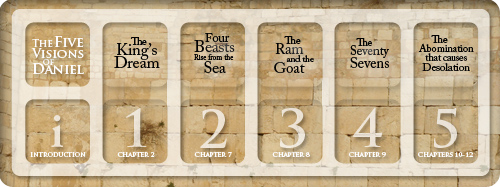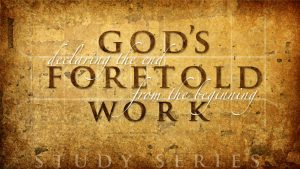I believe it is important that we affirm that the Jews, despite their current disobedience, are “the chosen people”. The age ends by a great international conflict called, “the controversy of Zion” (Isa 34:8; Zech 12:2-3; see the paper on my website recently found and posted, called, “The Significance of […]
Dominionism
I do not exaggerate when I say that I’ve never seen the prophetic portions of scripture handled more irresponsibly. This writer distorts and goes beyond the most extreme forms of non-millennial and anti-futurist viewpoints of preterism and / or amillennialism. At least those schools recognize a great tribulation and some form of Antichrist. Even if they interpret this to be Nero, or the 70 A.D. destruction of Jerusalem, still, they understand that any “dominion” that Christ secured at the cross did not mean that the early church would not face a future falling away and Antichrist persecution. Even on amillennial terms, Satan’s “little season” is still future, as this is where many amillennialists locate a future Antichrist, just prior to what they see as a general resurrection, with no millennium to follow.
Even in the view of preterists and amillennialists, the early church is not so completely ‘done with the devil’, as to be exempt from what was certainly to them a future tribulation and Antichrist (2Thes 2:3-4). The “dominion” of the fourth beast was not so completely broken, as to exempt the early church from its expectation of a future tribulation of unequaled severity (Dan 12:1; Mt 24:21; Rev 7:14).
The God Who Hides Himself
Thank you (and thank God!) for the piece I just re-read on “The Mystery of the Gospel”. The matter of the gem and its setting explains so succinctly the transition that my wife and I have undergone, as I have tried to express before, in this regard. But, once the […]
The Near-Far Interpretation of Prophecy
[…] In every context where the eschatological day of the Lord is in view, there is usually a near and a far fulfillment. This is seen most clearly by the simple fact that the messianic salvation, everywhere identified with a climactic post tribulational day of the Lord, simply did not happen. A view of the inerrancy of the inspired scripture, will, of course, demand that a gap be recognized between the past, near and partial fulfillment, and a future fulfillment that is complete and exhaustive.
Even if you happen to deny a distinct future for natural Israel, and even if you are prone to interpret scripture allegorically, one is still obliged to recognize that the promised messianic salvation did not come until much later with the advent of Jesus. Beyond the earnest and first fruits (the “already”) of Israel’s promised salvation, there remains the “not yet” of a yet future day of the Lord that will accomplish “the restoration of all things spoken by the prophets” (Acts 3:21; Ro 11:25-29).
[Note: The difference between pre-mill and a-mill eschatology is simply the question of how much of Israel’s promised salvation came in with the revelation of the gospel? All or part? […] […]
The Prince of the Covenant
Reggie, I heard you mention once that “the prince of the covenant” was someone other than Antichrist. Can you give me your thoughts on this? Watson [i.e. P.S.G. Watson] seems to have taught they are one and the same. See attached. Bro. Phil I have to differ with Watson on […]
Antiochus IV Epiphanes
Dear Reggie, As we seek to understand the prophecy in Daniel regarding the career of Antichrist and where it begins, I continue to get questions about the transition between Ch. 11:21 and 23 and why we are not giving any of this to fulfillment by Antiochus IV Epiphanes. We speak […]
Basic Outline of the Last “Seven”
Reggie, Rather than a final work could you at least send a rough outline. What starts the 3.5 years, what happens in the middle, then at the end of 7 years. You can refine later, but I need something to start with. I am traditional futurist in the basic outline […]
New Course | The Five Visions of Daniel

As of this weekend, all of the videos from the Sept 2010 Convocation regarding the prophet Daniel have now been posted on YouTube. (If there may be a few straggler segments we will update as necessary.) We have made mention of each session here as they have been posted, but we fear that as additional articles are put up over the coming weeks or months, this foundational material will get buried and neglected. Therefore it has been assembled and cross-linked so that it can more readily be found in it’s entirety.
In the banner at the top of every Mystery-of-Israel page there is a new section called “Courses” replacing the older section called “Apocalyptic Evangelism Course.” This new link references the still-in-progress work called “Apocalyptic Evangelism,” but now also the completed course on The Five Visions of Daniel.
The graphic above appears on each page of the course, so that easy reference to other chapters is available. We hope to link relevant articles and commentary to the appropriate lessons as time permits.
Our prayer is that this great book will open up afresh to God’s saints, and that they will find renewed confidence in His Word, His character and His glorious Name.
Introduction to Daniel: Pursuing the Lord’s Mandate (Video)
Phil Norcom and Reggie Kelly lead a discussion on the significance of the prophet Daniel for our current generation. They are accompanied by Mark Klafter and Fred London.
Daniel the Prophet: Pursuing the Lord’s Mandate (click/tap here if you see nothing below)




